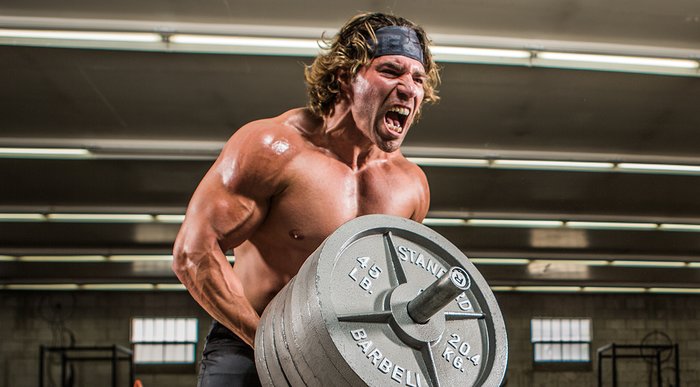Pain is one of the inarguable realities of life, but that doesn't mean you have no say in how you encounter it. You can wait comfortably, for years and years, until the day when pain finds you—and maybe never leaves. Or you can voluntarily get on familiar terms with pain and visit it on a regular basis. I think you know which approach I'm going to advocate.
In order for training to be effective for the long term, you must increase your perceived intensity—and the discomfort that accompanies it. From the 20-rep "breathing squats" of old, to the classic bodybuilder's double and triple dropsets, to today's CrossFit and HIIT, pain-promoting training circles in and out of vogue over the years. And it's definitely "in" right now.
"Sure, but that's not for everyone," someone is saying right now. I disagree. Everyone can and should get comfortable with pain. By avoiding it, you are missing out on the hormonal and physique benefits that strength training can provide. No, it doesn't feel "good." But your body has the ability to withstand loads of hurt and extreme levels of fatigue. The problem is that most gym goers don't have a strategy for how to deal with the pain when it hits them.

Here are three mental tips to help you deal with discomfort in your upcoming battle in the gym. By managing your perception of pain, you can take your body beyond what you thought you were capable of.
Get ready to feel unstoppable.
1. Understand the Benefits of Pain
Anyone who has spent a few years under the iron knows that the line between "good pain" and "bad pain" takes time and practice to understand. To be clear, high-pain-tolerance training is not about working through an injury; it is about working through the physical discomfort and stress of a challenging task. It's important to understand this distinction. If you're injured, get well before you do anything else.
That said, building your pain tolerance begins with acceptance. Understand that when you're doing a workout and your legs are burning and your lungs are pounding, you're at the right place where good things will happen. Being confident in the benefits will help you stomach the agony.

When you work out this intensely, your body undergoes an important neuroendocrine adaptation or hormonal change. It releases human growth hormone, testosterone, and other fat-burning, muscle-building hormones to enhance your body composition. But it doesn't happen to any meaningful degree when things are easy. In order to get these amazing physical benefits, you have to occasionally push your body as close to your limits as possible. Taking a slow jog or casually pumping up just won't get you these hormonal advantages.
Likewise, your body builds up a lactic-acid tolerance with repeated exposure, so the first time you do heavy high-rep squats, you may feel like you're going to croak after just 5 reps. Over time, however, you'll be able to do more and achieve more in the gym.
I know this doesn't sound fun, but many people who have successfully undergone transformations will tell you that it's only through this physical discomfort that profound change is possible. Over time, you'll realize that the benefits you'll get from the pain will outweigh the suffering.
2. Get Angry
Like pain, there is "good angry" and "bad angry." I'm not suggesting you train in an uncontrolled or chemically enhanced state of anger, because that can quickly get out of control. In the gym and in life, you never want your emotions to get the best of you.
However, anger—at yourself, or at someone who has doubted or crossed you—can be a powerful tool to employ when you find yourself ready to quit prematurely. Personally, I know I'm susceptible to giving up when I could go further. When I catch myself fading at the first sign of discomfort, I get incredibly upset for potentially wasting a training day.

Being upset at myself instantly fires me up to the point where I can bulldoze through a workout no matter how difficult it is. The discomfort is still there, but training while being pissed off can override plenty of the negative sensations of your muscles hurting.
Get mad. Then, get better.
3. Recall Your Past Painful Workouts
When you're in the heat of the moment in training, the pain and discomfort can seem so intense that you can't think about anything else. But with practice, you'll remember at least one thing: The last time you did this to yourself, you survived.
When the suffering comes, open up your mental Rolodex of past training sessions that were just as uncomfortable as this one. Maybe there are some that were worse—way worse. Knowing that you got through those will help make the current temporary challenge seem a lot easier.

You seriously have no idea where the limits of your potential truly are. Nobody does. All you have to guide you is what you've done before and what you're willing to believe right now. Revisiting your past victories will give you the closest thing you can get to concrete proof that you have the ability to endure and outdo pain.
The past is gone, but it has one use: It can help you feel more awesome in the present and be more awesome in the future. Let it!

